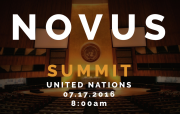Representatives of the science, technology and innovation communities discussed how current advances can support implementation of the Sustainable Development Goals (SDGs), during the NOVUS Summit, which took place alongside the 2016 session of the High-level Political Forum on Sustainable Development (HLPF).
The independently organized event, supported by the UN Department of Economic and Social Affairs (DESA), aimed to serve as an intergenerational platform to inspire action around the SDGs.
 17 July 2016: Representatives of the science, technology and innovation communities discussed how current advances can support implementation of the Sustainable Development Goals (SDGs), during the NOVUS Summit, which took place alongside the 2016 session of the High-level Political Forum on Sustainable Development (HLPF). The independently organized event, supported by the UN Department of Economic and Social Affairs (DESA), aimed to serve as an intergenerational platform to inspire action around the SDGs.The NOVUS Summit took place on 17 July 2016, at UN Headquarters in New York, US. The day-long event included meditation, a piano performance, 39 speakers and presentations, and an awards ceremony honoring 17 businesspeople and innovators.
17 July 2016: Representatives of the science, technology and innovation communities discussed how current advances can support implementation of the Sustainable Development Goals (SDGs), during the NOVUS Summit, which took place alongside the 2016 session of the High-level Political Forum on Sustainable Development (HLPF). The independently organized event, supported by the UN Department of Economic and Social Affairs (DESA), aimed to serve as an intergenerational platform to inspire action around the SDGs.The NOVUS Summit took place on 17 July 2016, at UN Headquarters in New York, US. The day-long event included meditation, a piano performance, 39 speakers and presentations, and an awards ceremony honoring 17 businesspeople and innovators.
Marcus Shingles, CEO, XPRIZE Foundation, observed the potential of technological advances to ensure that no one is left behind with regard to internet access, such as Elon Musk’s planned satellites or the Facebook drones that aim to provide internet access for the most remote areas. He invited participants to imagine a world of 7 billion entrepreneurs that address the global challenges, and spoke of the advantages provided by the “democratization of solutions” and the “gamification of innovation” (public competitions for solutions to a certain challenge). Peter Diamandis, XPRIZE Foundation, said we are on a path of reinventing society, and have access to the necessary science to become a multi-planetary species. He called for regarding the biggest world’s problems as the biggest business opportunities, for example by using mobile technology to bring education to illiterate people.
Naveen Jain, CEO, InfoSpace, said the best way to unite people is through entrepreneurship, as entrepreneurs and investors forget about geographical boundaries. He called for a change from a mindset of scarcity to a mindset of abundance, solutions-oriented and focused on opportunities, noting that there is no problem big enough that entrepreneurs and innovation cannot solve. Johannes Eichstaedt, University of Pennsylvania, gave examples of innovation in health, such as applications that can use Twitter to predict rates of coronary heart disease.
Cecilia Conrad, MacArthur Foundation, presented the ‘100&Change’ competition launched on 2 June 2016, which will award a US$100 million grant to a single proposal designed to help solve a critical problem affecting people or the planet. Leona Brandwene, University of Pennsylvania, stressed that the planet is going through an important demographic change: by 2050 the number of people older than 65 years old will increase to 1.5 billion and will outnumber the number of children under five years old. Giving a few examples of people who stayed fit, healthy and independent after 70 because of a healthy and active lifestyle and a positive mindset, she called for changing the mindset of our communities towards “positive aging” instead of regarding it as a physical decline, which triggers complacent behaviors and burdens both the aging population and the young population supporting it.
Raymond McCauley, Singularity University, spoke about the potential of biohacking to tackle global challenges. Lamenting that biotechnology’s potential stays “locked up” in academia and commerce, he called for biohacking tools that empower people to participate, including through community labs that can be centers for education and innovation. Thomas Ermecora, World Economic Forum on Urban Futures, called for creating a network of “regenerated villages” by: engaging communities in co-designing commons; building networks that empower community as a whole; and empowering community members through technology.
Noting that “the opposite of community is calamity,” Khaliya Ermacora, Founder of Falkora, said commons should be catalysts for cohesion. She spoke about the Guardian Circle free app, which uses peer-to-peer technology to connect an invited network of family, friends and neighbors to cross-communicate in real-time, improving critical response time and efficiency in different emergency cases and more common help requests, such as medical emergency, car breakdown, the need to pick up a child, or a woman feeling at risk on a date or on the street at night.
Jennifer Lopez, International Space Station, said NASA’s water-processing developed for the space station has been commercialized and deployed by the Water Security Corporation to provide aid and disaster relief for communities worldwide. Other applications of space technology include: the use of Advanced Diagnostic Ultrasound in Microgravity for remote medical care, as used for people living aboard the space station; and the use of the space station’s imaging system to capture photographs of Earth of developing countries affected by natural disasters.
Closing the meeting, Kunal Sood, NOVUS Summit founder, stressed the need for people to become not just “go-getters” but also “go-givers.” [NOVUS Summit Website] [DESA Website] [IISD RS Sources]